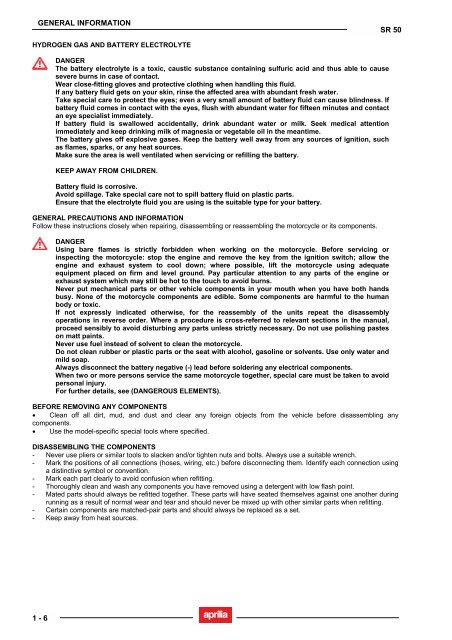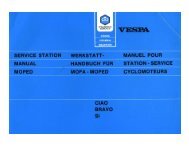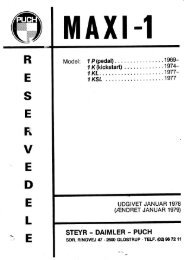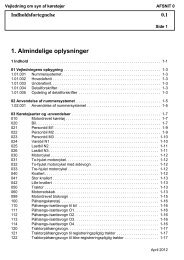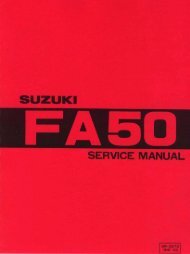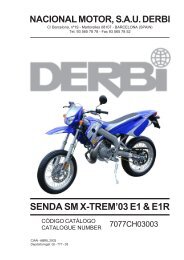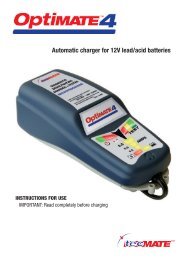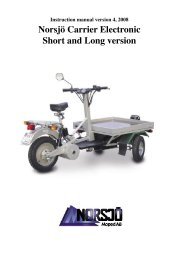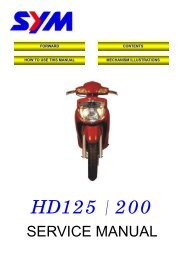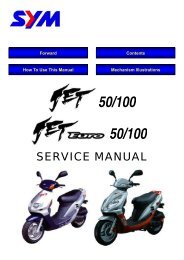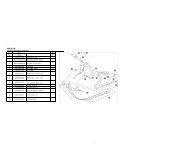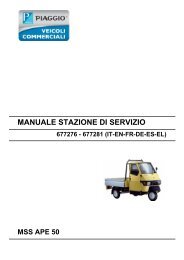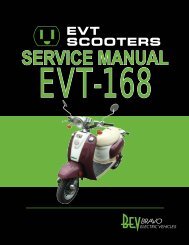Aprilia SR 50 servicemanual - Scootergrisen
Aprilia SR 50 servicemanual - Scootergrisen
Aprilia SR 50 servicemanual - Scootergrisen
You also want an ePaper? Increase the reach of your titles
YUMPU automatically turns print PDFs into web optimized ePapers that Google loves.
GENERAL INFORMATION<br />
HYDROGEN GAS AND BATTERY ELECTROLYTE<br />
1 - 6<br />
DANGER<br />
The battery electrolyte is a toxic, caustic substance containing sulfuric acid and thus able to cause<br />
severe burns in case of contact.<br />
Wear close-fitting gloves and protective clothing when handling this fluid.<br />
If any battery fluid gets on your skin, rinse the affected area with abundant fresh water.<br />
Take special care to protect the eyes; even a very small amount of battery fluid can cause blindness. If<br />
battery fluid comes in contact with the eyes, flush with abundant water for fifteen minutes and contact<br />
an eye specialist immediately.<br />
If battery fluid is swallowed accidentally, drink abundant water or milk. Seek medical attention<br />
immediately and keep drinking milk of magnesia or vegetable oil in the meantime.<br />
The battery gives off explosive gases. Keep the battery well away from any sources of ignition, such<br />
as flames, sparks, or any heat sources.<br />
Make sure the area is well ventilated when servicing or refilling the battery.<br />
KEEP AWAY FROM CHILDREN.<br />
Battery fluid is corrosive.<br />
Avoid spillage. Take special care not to spill battery fluid on plastic parts.<br />
Ensure that the electrolyte fluid you are using is the suitable type for your battery.<br />
GENERAL PRECAUTIONS AND INFORMATION<br />
Follow these instructions closely when repairing, disassembling or reassembling the motorcycle or its components.<br />
DANGER<br />
Using bare flames is strictly forbidden when working on the motorcycle. Before servicing or<br />
inspecting the motorcycle: stop the engine and remove the key from the ignition switch; allow the<br />
engine and exhaust system to cool down; where possible, lift the motorcycle using adequate<br />
equipment placed on firm and level ground. Pay particular attention to any parts of the engine or<br />
exhaust system which may still be hot to the touch to avoid burns.<br />
Never put mechanical parts or other vehicle components in your mouth when you have both hands<br />
busy. None of the motorcycle components are edible. Some components are harmful to the human<br />
body or toxic.<br />
If not expressly indicated otherwise, for the reassembly of the units repeat the disassembly<br />
operations in reverse order. Where a procedure is cross-referred to relevant sections in the manual,<br />
proceed sensibly to avoid disturbing any parts unless strictly necessary. Do not use polishing pastes<br />
on matt paints.<br />
Never use fuel instead of solvent to clean the motorcycle.<br />
Do not clean rubber or plastic parts or the seat with alcohol, gasoline or solvents. Use only water and<br />
mild soap.<br />
Always disconnect the battery negative (-) lead before soldering any electrical components.<br />
When two or more persons service the same motorcycle together, special care must be taken to avoid<br />
personal injury.<br />
For further details, see (DANGEROUS ELEMENTS).<br />
<strong>SR</strong> <strong>50</strong><br />
BEFORE REMOVING ANY COMPONENTS<br />
• Clean off all dirt, mud, and dust and clear any foreign objects from the vehicle before disassembling any<br />
components.<br />
• Use the model-specific special tools where specified.<br />
DISASSEMBLING THE COMPONENTS<br />
- Never use pliers or similar tools to slacken and/or tighten nuts and bolts. Always use a suitable wrench.<br />
- Mark the positions of all connections (hoses, wiring, etc.) before disconnecting them. Identify each connection using<br />
a distinctive symbol or convention.<br />
- Mark each part clearly to avoid confusion when refitting.<br />
- Thoroughly clean and wash any components you have removed using a detergent with low flash point.<br />
- Mated parts should always be refitted together. These parts will have seated themselves against one another during<br />
running as a result of normal wear and tear and should never be mixed up with other similar parts when refitting.<br />
- Certain components are matched-pair parts and should always be replaced as a set.<br />
- Keep away from heat sources.


